Related Research Articles

A platformer is a sub-genre of action video games in which the core objective is to move the player character between points in an environment. Platform games are characterized by levels with uneven terrain and suspended platforms of varying height that require jumping and climbing to traverse. Other acrobatic maneuvers may factor into the gameplay, such as swinging from vines or grappling hooks, jumping off walls, gliding through the air, or bouncing from springboards or trampolines.
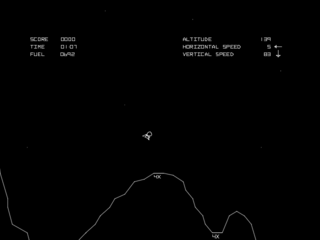
Lunar Lander is a genre of video games loosely based on the 1969 landing of the Apollo Lunar Module on the Moon. In Lunar Lander games, players control a spacecraft as it falls toward the surface of the Moon or other astronomical body, using thrusters to slow the ship's descent and control its horizontal motion to reach a safe landing area. Crashing into obstacles, hitting the surface at too high a velocity, or running out of fuel all result in failure. In some games in the genre, the ship's orientation must be adjusted as well as its horizontal and vertical velocities.
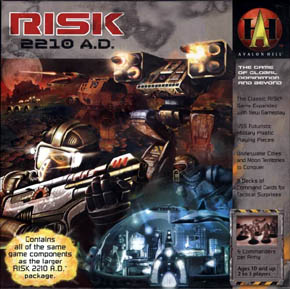
Risk 2210 A.D. is a 2–5 player board game by Avalon Hill that is a futuristic variant of the classic board game Risk. Risk 2210 A.D. was designed by Rob Daviau and Craig Van Ness and first released in 2001. In 2002, it won the Origins Award for "Best Science Fiction or Fantasy Board Game of 2001".

SimTown is a 1995 video game published by Maxis, much like the best-selling SimCity but on a smaller scale. SimTown allows the player to construct a town consisting of streets, houses, businesses and parks and then control the people in it. SimTown is one of the many "Sim" spin-offs from SimCity, and was targeted more towards children. The Macintosh version was released in May 1995.

Moon Patrol is a 1982 arcade video game developed and released by Irem. It was licensed to Williams for distribution in North America. The player controls a Moon buggy which can jump over and shoot obstacles on a horizontally scrolling landscape as well as shoot aerial attackers. Designed by Takashi Nishiyama, Moon Patrol is often credited with the introduction of full parallax scrolling in side-scrolling games. Cabinet art for the Williams version was done by Larry Day. Most of the home ports were from Atari, Inc., sometimes under the Atarisoft label.

Kung-Fu Master, known as Spartan X in Japan, is a side-scrolling beat 'em up developed by Irem as an arcade video game in 1984, and distributed by Data East in North America. Designed by Takashi Nishiyama, the game was based on Hong Kong martial arts films. It is a loose adaptation of the Jackie Chan, Sammo Hung, and Yuen Biao film Wheels on Meals (1984), called Spartan X in Japan, with the protagonist Thomas named after Jackie Chan's character in the film. The game is also heavily inspired by the Bruce Lee film Game of Death (1972), which was the basis for the game's concept. Nishiyama, who had previously designed the side-scrolling shooter Moon Patrol (1982), combined fighting elements with a shoot 'em up gameplay rhythm. Irem and Data East exported the game to the West without the Spartan X license.

The Legend of Kage is a side-scrolling hack-and-slash game developed and published by Taito in 1985. In this game, the player controls the ninja Kage, with the objective being to get through five stages in order to save the princess Kirihime. These stages are littered with enemies, however Kage has various skills and weapons on his hands in order to get through them.

Moonmist is an interactive fiction computer game written by Stu Galley and Jim Lawrence and published by Infocom in 1986. The game was released simultaneously for the Amiga, Amstrad CPC, Apple II, Atari 8-bit family, Atari ST, Commodore 64, MS-DOS, TRS-80, TI-99/4A, and Macintosh. It is Infocom's twenty-second game. Moonmist was re-released in Infocom's 1995 compilation The Mystery Collection, as well as the 1996 compilation Classic Text Adventure Masterpieces.

Star Goose is a vertically scrolling shooter that was published for the Amiga, Atari ST, and MS-DOS by Logotron in 1988. The player controls Scouser-Gitt, who pilots the eponymous Star Goose, a vessel that has been commissioned to scour the planet Nom and collect 48 crystals. Players must collect all six crystals in each of the game's eight levels to advance, while at the same time avoiding or destroying enemies and maintaining their shield, ammunition, and fuel levels. The game's surfaces are contoured, which affects the way that bullets travel, and contain tunnels that switch modes to a three-dimensional perspective where the player can replenish their resources.
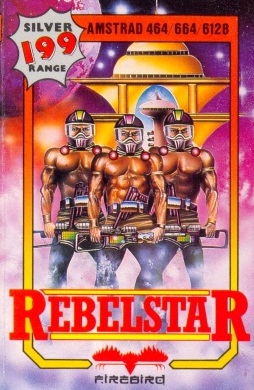
The Rebelstar games are a series of turn-based tactics video games designed by Julian Gollop. Rebelstar Raiders was published in 1984 by Red Shift for the ZX Spectrum. It was reworked in machine code as Rebelstar, published by Firebird in 1986. A sequel, Rebelstar II, was published in 1988 by Silverbird. Rebelstar, but not its sequel, was also adapted for the Amstrad CPC home computer.

ABA Games is a Japanese video game developer, composed solely of game designer Kenta Cho. ABA Games' works, available as open source, are predominantly shoot 'em up games often inspired by classic games in the genre. Its games feature stylised retro graphics, innovative gameplay features and modes and feature random rather than scripted events. These creations have been acclaimed as some of the best independent games available, though some commentators, including Cho himself, feel they are too simple for commercial release.
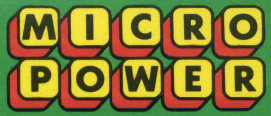
Micro Power was a British company established in the early 1980s by former accountant Bob Simpson. The company was best known as a video game publisher, originally under the name Program Power. It also sold many types of computer hardware and software through its Leeds 'showroom' or via mail order.

The Dungeon Revealed is a dungeon crawl PC game created by John Raymonds and published by Woodrose Editions in 1987. The game is an enhanced commercial release of Raymonds' previous game The Dungeon of Doom, released as shareware in 1985. A final version of The Dungeon of Doom was released as a free demo for The Dungeon Revealed in 1987. Both games were released for Mac OS and were compatible with versions as late as System 7.

Crystal Quest is an action game written by Patrick Buckland for the Macintosh and published by Casady & Greene in 1987. It was ported to the Apple IIGS in 1989 by Rebecca Heineman. Ports were also made to the Amiga, Game Boy, iOS, and Palm. It was the first game to support the color displays of the Macintosh II.

Oids is a multidirectional shooter developed and self-published by FTL Games in 1987. The game was originally released on the Atari ST, followed by a B&W version for the classic 68k Macintosh in 1990. The Atari ST version, written by Dan Hewitt, was a cult favourite in the UK, where it received rave reviews.

To Hell and Back is a platform game developed for the Commodore 64 by Andy Jervis and published by CRL in 1988. Jervis' first game Moon Crystals was also included, although this was unmentioned in the game's packaging or press releases.

The Computer Edition of Scrabble is a computer game developed by Leisure Genius for the Macintosh in 1988, and was an official computerized version of the board game Scrabble.

Game Over II is a combination scrolling shooter and platform game developed and published by Dinamic Software in 1987 for the ZX Spectrum, MSX, MS-DOS, Amstrad CPC, Commodore 64, and Atari ST.
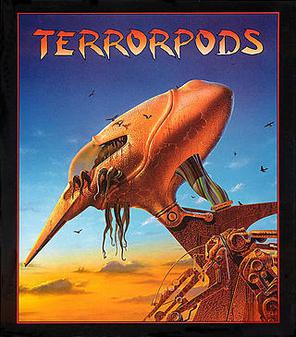
Terrorpods is a 1987 shooting game with simple business simulation by Psygnosis. Originally developed for the Amiga and Atari ST, it was later ported to the Commodore 64, ZX Spectrum, Amstrad CPC and MSX.

Atari Vault is a video game collection developed byCode Mystics and published by Atari Interactive for Microsoft Windows, macOS, and Linux via the Steam client. Atari Vault contains titles from Atari, Inc. and Atari Corporation published on the Atari 2600 and arcade cabinets. dating from the 1970s, 1980s, and 1990s. The games, where possible, have been updated to include modern-day features such as local and online multiplayer and online leaderboards.
References
- ↑ "Test Flight: Game Scenario". Lunar Rescue game manual. Practical Computer Applications, Inc. 1988. pp. 7–8.
- ↑ Husten, Larry (February 1989). "Lunar Rescue". MacUser . 5 (2). Ziff-Davis Publishing Co.: 347.
- ↑ McCandless, Keith (November 1988). "Lunar Rescue 1.0". Macworld . 5 (11). PCW Communications, Inc.: 170–172.